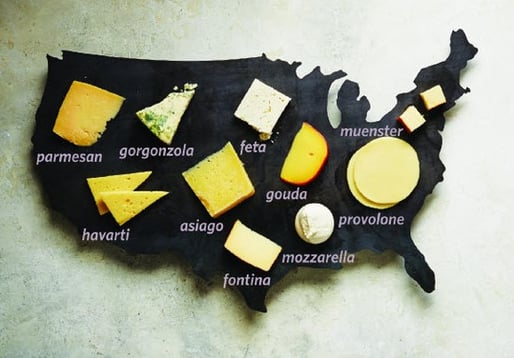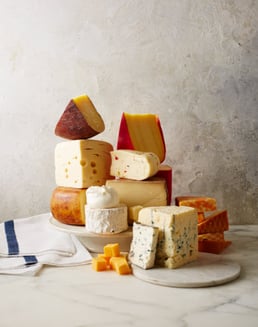-
Why Europe Must not own 'Parmesan' and 'Feta'
By Errico Auricchio July 14, 2015- Tweet
Cheese names could be discussed again as U.S. and EU negotiators meet this week for another round of TTIP talks.
Editor’s Note: Errico Auricchio is the owner of BelGioioso Cheese in Green Bay, Wis., and the chairman of The Consortium for Common Food Names, an international initiative to preserve the right to use generic food names. The Consortium is supported by food producers and is staffed by the U.S. Dairy Export Council. This guest blog post, first published in Cheese Market News, is republished here in light of this week's TTIP talks in Brussels.

As chairman of the Consortium for Common Food Names, I sincerely hope the United States and European Union (EU) can find common ground on the issue of protecting proprietary names of cheeses and other foods, which at the same time must include protection of generic names in public use for generations, such as “feta” and “parmesan.”
The EU’s position on geographical indications (GIs) is a major stumbling block in the current negotiations between the United States and EU on the Trans-Atlantic Trade and Investment Partnership (TTIP) trade agreement, as well as in other international forums. But I don’t believe it has to be so.
Last summer, U.S. Secretary of Agriculture Tom Vilsack told the Europeans he hoped all parties involved could find a “sweet spot” on the issue, examining in particular the interplay of the U.S. trademark system and GIs.
The U.S. position is that our trademark system is robust enough to protect European products, and in fact it already does. U.S. Trade Representative Michael Froman recently stated his belief that the system “works for Europe and the rest of the world,” adding that “There are 18 trademarks for Parmigiano Reggiano in the U.S., and Europe sells hundreds of millions of dollars of cheese in the United States . . . We can have a system where countries can take into account common names and trademarks before they grant any geographical indications."

In my view, the crux of the issue is this: Unlike U.S. trademark law, the EU does not follow consistent, equitable rules in how it establishes GIs. The main point of contention is not the existence of GIs, but the lack of consistency and fairness in how they are created and protected.
Essentially, a GI is a type of trademark. It entitles the holder to exclusive use of a name. Like our trademark system in the United States, GI applicants should be held to certain criteria, namely:
- A protected name should not infringe on the ability of others to use generic terms that are in the public domain.
- Establishing a protected name should not create confusion to consumers in the marketplace, but rather should provide clarity by distinguishing the product from others. In return for meeting these and other criteria standard in trademark law, the holder gains the privilege of exclusive use to a name or term.

But for the EU to state unilaterally that only small, discrete regions of the world can use common names like “asiago”, “feta” or “parmesan” clearly infringes on others’ rights in the marketplace, and is clearly confusing to consumers. Consider that these cheeses have been sold in a variety of nations worldwide for decades. Parmesan has been made in the United States since about 1900, and much more parmesan is made outside the EU than within it!
Clearly, the GI “Parmigiano Reggiano” is identifiable as a name for a specialty Italian cheese. Both “Parmigiano Reggiano” and “parmesan” can and must co-exist in the global marketplace.
Beyond the potential for consumer confusion, the EU provides no clarity as to the extent of GI protections once they are introduced. Does the EU consider “provolone” a protected term or not? In Europe, it is not. A Codex Alimentarius standard exists attesting to the generic-ness of the term. Yet in Costa Rica the EU has argued that solely Italian producers should have the right to use that term, and the Costa Rican government appears to be swayed by this argument despite its commitments under the U.S.-Central America Free Trade Agreement (CAFTA).
This is just one small example—we could name many. This inconsistency is unacceptable; it creates slippery GIs that do not follow set rules.
Since the dawn of packaged foods, Americans have recognized that most foods they buy originate back to another part of the world. Not until recently has Europe attempted so strongly to prevent American, Argentine, Australian or other marketers from drawing on that heritage. But culture is not tied to a piece of land—culture is in the people. As people move, the culture moves. You cannot stop the spread of culture, and you cannot roll back markets once developed. As a business person, why would you want to?
I’m hopeful that food producers in the United States and EU will find a “sweet spot” in respect to proprietary and common names. But for progress to be made, the EU needs to establish GI policies that are based on consideration of the marketplace and consistent rules—qualities already present in U.S. trademark law.
The U.S. Dairy Export Council is primarily supported by Dairy Management Inc. through the dairy farmer checkoff that builds on collaborative industry partnerships with processors, trading companies and others to build global demand for U.S. dairy products.
Images are the property of USDEC and should not be republished unless permission is given.
10 Most Recent Posts
Most Popular Posts in Past Year
Index of Posts by Topic
- #GotDairyJobs (4)
- About USDEC (66)
- Africa (6)
- Australia (4)
- Blog (8)
- Brazil (4)
- Canada (20)
- Central America (1)
- Cheese (58)
- Chile (1)
- China (54)
- Common food names (7)
- Company News (19)
- Consistent Supply (1)
- Crisis Management (3)
- Cuba (2)
- Dairy (6)
- Dairy checkoff (9)
- Dairy Ingredients (5)
- Dairy Management Inc. (2)
- Dairy Resources (1)
- Dairy Supply Chain (1)
- Dairy Trends (5)
- Documentation (3)
- EU (24)
- Experts on Dairy Exports (4)
- Exporter of the Year (2)
- Exports (24)
- Farmer leaders (1)
- Farming (38)
- Food Aid (8)
- Food Safety (8)
- Foodservice (3)
- Free trade agreements (34)
- Future trends (1)
- Geographical Indications (GIs) (10)
- Global Marketing (86)
- Global Shipping Crisis (1)
- Got Jobs? (9)
- Indonesia (1)
- Innovation (17)
- Japan (17)
- Krysta Harden (1)
- Market Access (25)
- Market Conditions (268)
- Member Services (17)
- Mexico (41)
- Middle East (9)
- Middle East & North Africa (3)
- Middle East/North Africa (9)
- Milk (4)
- Milk Protein Concentrate (MPC) (2)
- New Zealand (11)
- Next5% (20)
- Nonfat Dry Milk/Skim Milk Powder (8)
- Nutrition (19)
- Product Innovation (6)
- Protein (4)
- Regulations (5)
- Research & Data (326)
- Russia (3)
- Singapore (10)
- South America (8)
- South Korea (10)
- Southeast Asia (25)
- Strategic Insights (1)
- Supply (1)
- Sustainability (26)
- Technology (2)
- ThinkUSADairy (5)
- TPM23 (1)
- TPP (13)
- Traceability (8)
- Trade Barriers (5)
- Trade Data (7)
- Trade Policy (72)
- TTIP (5)
- UHT Milk (7)
- USMCA (2)
- Vietnam (4)
- Whey (6)
- Whey Ingredients (2)
- Whey products (10)
- Whole Milk Powder (WMP) (3)
- World Dairy Expo (1)
- World Milk Day (1)
- Yogurt (1)
Index of Posts by Date, Author
- June 2021 (13)
- March 2015 (12)
- September 2015 (12)
- April 2015 (11)
- December 2015 (11)
- March 2014 (10)
- February 2015 (10)
- October 2015 (10)
- October 2014 (9)
- June 2015 (9)
- July 2015 (9)
- November 2015 (9)
- March 2016 (9)
- October 2019 (9)
- September 2013 (8)
- May 2015 (8)
- August 2015 (8)
- January 2016 (8)
- February 2016 (8)
- March 2017 (8)
- December 2018 (8)
- May 2019 (8)
- December 2019 (8)
- June 2014 (7)
- November 2016 (7)
- May 2017 (7)
- May 2018 (7)
- July 2020 (7)
- June 2023 (7)
- July 2016 (6)
- August 2018 (6)
- October 2018 (6)
- November 2018 (6)
- February 2019 (6)
- June 2019 (6)
- August 2019 (6)
- March 2020 (6)
- April 2020 (6)
- June 2020 (6)
- June 2022 (6)
- February 2014 (5)
- June 2016 (5)
- August 2016 (5)
- September 2016 (5)
- December 2016 (5)
- February 2017 (5)
- July 2017 (5)
- October 2017 (5)
- January 2018 (5)
- April 2018 (5)
- June 2018 (5)
- July 2018 (5)
- September 2018 (5)
- January 2019 (5)
- March 2019 (5)
- April 2019 (5)
- July 2019 (5)
- September 2019 (5)
- November 2019 (5)
- January 2020 (5)
- August 2020 (5)
- October 2020 (5)
- April 2021 (5)
- January 2022 (5)
- May 2013 (4)
- September 2014 (4)
- April 2016 (4)
- May 2016 (4)
- October 2016 (4)
- January 2017 (4)
- April 2017 (4)
- June 2017 (4)
- August 2017 (4)
- September 2017 (4)
- December 2017 (4)
- February 2018 (4)
- February 2020 (4)
- May 2020 (4)
- February 2022 (4)
- September 2022 (4)
- April 2023 (4)
- December 2023 (4)
- November 2017 (3)
- March 2018 (3)
- September 2020 (3)
- December 2020 (3)
- February 2021 (3)
- May 2021 (3)
- August 2021 (3)
- December 2021 (3)
- March 2022 (3)
- April 2022 (3)
- May 2022 (3)
- October 2022 (3)
- December 2022 (3)
- May 2023 (3)
- July 2023 (3)
- November 2023 (3)
- March 2011 (2)
- June 2011 (2)
- September 2011 (2)
- March 2012 (2)
- June 2012 (2)
- July 2012 (2)
- March 2013 (2)
- July 2013 (2)
- November 2020 (2)
- January 2021 (2)
- March 2021 (2)
- July 2021 (2)
- September 2021 (2)
- October 2021 (2)
- November 2021 (2)
- July 2022 (2)
- August 2022 (2)
- January 2023 (2)
- March 2023 (2)
- October 2023 (2)
- January 2024 (2)
- February 2024 (2)
- April 2024 (2)
- June 2024 (2)
- July 2024 (2)
- November 2024 (2)
- December 2024 (2)
- February 2025 (2)
- June 2025 (2)
- July 2025 (2)
- September 2025 (2)
- November 2025 (2)
- January 2010 (1)
- February 2010 (1)
- March 2010 (1)
- April 2010 (1)
- May 2010 (1)
- June 2010 (1)
- July 2010 (1)
- August 2010 (1)
- September 2010 (1)
- October 2010 (1)
- November 2010 (1)
- December 2010 (1)
- January 2011 (1)
- February 2011 (1)
- April 2011 (1)
- May 2011 (1)
- July 2011 (1)
- August 2011 (1)
- October 2011 (1)
- November 2011 (1)
- December 2011 (1)
- January 2012 (1)
- February 2012 (1)
- April 2012 (1)
- August 2012 (1)
- September 2012 (1)
- October 2012 (1)
- November 2012 (1)
- December 2012 (1)
- January 2013 (1)
- February 2013 (1)
- April 2013 (1)
- June 2013 (1)
- August 2013 (1)
- October 2013 (1)
- November 2013 (1)
- December 2013 (1)
- January 2014 (1)
- April 2014 (1)
- May 2014 (1)
- November 2022 (1)
- February 2023 (1)
- August 2023 (1)
- September 2023 (1)
- March 2024 (1)
- May 2024 (1)
- August 2024 (1)
- September 2024 (1)
- October 2024 (1)
- January 2025 (1)
- March 2025 (1)
- April 2025 (1)
- May 2025 (1)
- August 2025 (1)
- December 2025 (1)
- USDEC (183)
- USDEC Staff (163)
- Alan Levitt (119)
- Tom Suber (41)
- Margaret Speich (22)
- Marc A.H. Beck (15)
- Vikki Nicholson-West (11)
- Angélique Hollister (11)
- Tom Vilsack (8)
- Jaime Castaneda (7)
- Matt McKnight (7)
- Véronique Lagrange (7)
- Margaret Speich and Mark O'Keefe (7)
- Ross Christieson (7)
- Paul Rogers (6)
- Shawna Morris (5)
- William Loux (5)
- Alan Levitt and Marc Beck (5)
- Krysta Harden (4)
- USDEC Communications (3)
- Kristi Saitama (3)
- Marilyn Hershey (3)
- Brad Gehrke (3)
- Tom Quaife (2)
- Nick Gardner (2)
- Jim Mulhern (2)
- Alan Levitt and William Loux (2)
- Kara McDonald (2)
- Luke Waring (2)
- Merle McNeil (2)
- Andrei Mikhalevsky (1)
- Rodrigo Fernandez (1)
- Dermot Carey (1)
- Jeremy Travis (1)
- Annie Bienvenue (1)
- Ross Christieson and Shawna Morris (1)
- Becky Nyman (1)
- Paul Rogers and Tom Quaife (1)
- Rick Ortman (1)
- Tony Rice (1)
- Barbara O’Brien (1)
- Paul Rogers and Mark O'Keefe (1)
- Dalilah Ghazalay (1)
- Amy Wagner (1)
- Mitchell Bowling (1)
- Erica Louder (1)
- Brad Scott (1)
- Amy Foor (1)
- Scott Lantz (1)
- Sandra Benson (1)
- Errico Auricchio (1)
- Jaclyn Krymowski (1)
- Krysta Harden, USDEC President and CEO (1)
.png)

